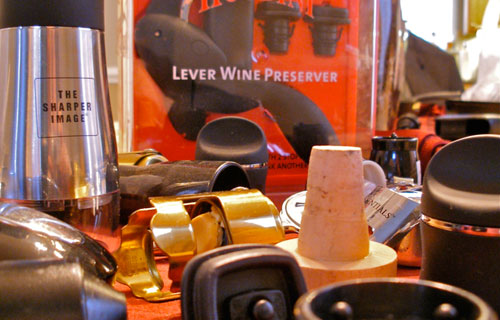Part 1 of 4 – Wine Preservation Overview
One important question that I hear all the time is what do you do with the bottle if you are unable to finish it right then and there. As more and more people are drinking wine, many new products are being created or updated – and are hitting the market to capitalize on the trend.
I run into this situation from time to time – but clearly the best way to avoid this situation is to enjoy it all so this won’t come up. Ok, seriously, that is not a good idea if you are driving or operating heavy machinery.
As I mentioned in an earlier post about storing your wine, much of what is out on the shelves is for immediate consumption. This also means that once opened, the shelf-life will fade very fast. Oxidation (aka maderization) is the enemy here. So, what to do to prolong this and be able to enjoy it later?
There are many products in stores that can help extend the life of the wine once opened. Over the years, I think I have purchased and tried just about all of them. I will speak to some of the newer products with interesting use of technology and features in a later post.
I have tried many methods and tricks and have come to this conclusion. Hurry! These gadgets work to remove the oxygen and create a vacuüm that can help slow down (never prevent) the eventual spoilage from oxidation. Cooler is also better!
There are three basic catch-all categories of preservers that I will be discussing here:
- 1) Pumps: Manual or battery/ac charged pump that works like a tire pump, but instead of putting air in, it takes it out and forms a seal. “I’m tellin ya baby, that’s not mine”– Austin Powers 1997 (warning: possibly NSFW). Sharper Image, Vino Vac and Houdini are three widely available models.
- 2) Gas Injectors: A pricier option that I have used on my finest and most expensive bottles. Producers like PEK puts an inert layer of gas on top of the wine, so that air can not get to it.
- 3) Change the Vessel: Easiest and cheapest option (and sometimes used with either 1 or 2). Simply buy a half bottle of your favorite wine, or ask a friend that has an empty half bottle you can use. Alternately, there are decanter “wine saver sets” on the market. The concept with this third option is to change (reduce) the percentage of wine exposed to the air.
I will be expanding on the above mentioned methods in upcoming posts to break down these options and speak to the pros and cons of each. Stay tuned!
Thanks for your participation, as always.
Steve from the Trellis
steve@talesfromthetrellis.com
© Tales from the Trellis 2010

Recent Comments